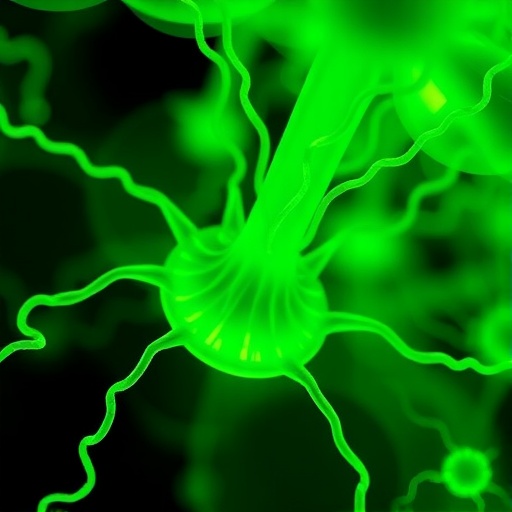In the relentless quest to revolutionize energy storage, solid-state batteries have emerged as a beacon of hope, promising unparalleled safety, energy density, and longevity compared to their liquid electrolyte counterparts. Central to this innovation are sulfide solid electrolytes, whose ionic conductivity and stability have propelled them to the forefront of battery research. However, the synthesis of lithium sulfide (Li₂S), a pivotal component in these electrolytes, traditionally relies on energy-intensive processes laden with environmental and economic drawbacks. A groundbreaking study published in Nature Communications by Zhang, Gao, Zheng, and colleagues introduces an eco-friendly approach that may hold the key to transforming this landscape.
The research delves into an innovative green synthesis method for Li₂S aimed at surmounting the critical limitations that have historically hindered sustainable and scalable production. Conventional routes necessitate harsh conditions—such as high temperature and vacuum environments—that escalate production costs and emit hazardous byproducts. The new methodology, however, employs a benign, low-temperature protocol that significantly curtails energy consumption while enhancing material purity and performance.
One of the study’s core achievements lies in synthesizing Li₂S using an environmentally benign sulfur source combined with a mild chemical reduction process. This paradigm shift not only mitigates the risks associated with volatilized sulfur compounds but also addresses the issue of volatile organic solvents, typically used in such processes, that pose both health risks and environmental challenges. By leveraging this clean chemistry, the resultant Li₂S exhibits fewer impurities, crucial for optimizing electrolyte behavior.
Detailing the electrochemical properties of the Li₂S produced, the team reports remarkably improved ionic conductivity and stability metrics. These enhancements translate directly to the performance of the sulfide solid electrolytes when incorporated into battery prototypes. The synthesized Li₂S demonstrates superior interface compatibility with lithium metal anodes, a historical hurdle due to the dendritic growth and interfacial resistance. Through rigorous impedance spectroscopy and cycling stability tests, the material showcases a notable reduction in interfacial deterioration, marking a significant step forward in solid electrolyte design.
Equally transformative is the eco-conscious scalability of the synthesis process. The authors meticulously outline how their green synthesis can be adapted to industrial scales without compromising the integrity or performance of the Li₂S product. This scalability is critical for bridging the gap between laboratory breakthroughs and commercial adoption—a necessary leap to realize the full potential of solid-state batteries in electric vehicles and grid energy storage applications.
Beyond the immediate technical triumphs, the research resonates profoundly within the broader context of sustainable manufacturing. Lithium-ion battery production today grapples with the twin challenges of ecological footprint and resource scarcity. By pioneering a green synthesis avenue for pivotal electrolyte materials, this study offers a tangible pathway to reduce the carbon footprint and lifecycle environmental impacts of next-generation batteries, aligning the field closer with global climate goals.
The intricacies of the green synthesis also open vistas for further material innovation. The authors suggest that their approach could pave the way for doping and compositional tuning of Li₂S, enabling the fine-tuning of electrolyte properties for specific applications. Such materials engineering could be pivotal in addressing lingering challenges such as electrolyte-electrode interfacial resistance, mechanical robustness, and high-temperature stability.
From a mechanistic standpoint, the study sheds light on the underlying chemical pathways and thermodynamics propelling the reaction. Their analysis, supported by advanced characterization techniques like X-ray diffraction and electron microscopy, reveals a controlled nucleation and growth process of Li₂S crystals. This precision enhances phase purity and crystallinity, factors intimately linked with the ionic conduction pathways fundamental to high battery performance.
In addition, the authors explore the compatibility of the newly synthesized Li₂S with various cathode materials, unveiling synergies that could further amplify battery energy density. Such interfacial compatibility is vital to prevent phase segregation and capacity fading, challenges that have historically constrained the scaling of sulfide electrolytes.
The paper also positions the green synthesis approach within the broader innovation ecosystem of battery materials research. It juxtaposes this work against emerging trends in solid electrolyte design, including oxide-based and polymer-based systems, underscoring sulfide electrolytes’ unique advantages in ionic mobility and interface adaptability.
Interestingly, the study offers insights into the long-term cycling performance and safety implications of batteries employing the green-synthesized Li₂S. By minimizing impurities and enhancing structural integrity, the electrolytes demonstrate resistance to thermal runaway and chemical degradation—two critical factors for real-world application safety standards.
This research not only pushes the frontier of electrolyte materials but also catalyzes a paradigm shift toward sustainability in battery manufacturing. It embodies the necessity of integrating materials science innovation with green chemistry principles, illuminating a pathway where technological advancement harmonizes with environmental stewardship.
Furthermore, the collaborative nature of the work—evident in the multidisciplinary team comprising experts in chemistry, materials science, and electrochemical engineering—highlights the importance of interdisciplinary approaches in overcoming complex technological barriers.
Looking ahead, the implications of this green synthesis extend beyond lithium batteries; the methodologies and insights might inspire analogous sustainable practices in other domains, such as sodium-ion batteries and beyond. This amplifies its impact across the energy storage sector and supports the global transition to cleaner energy systems.
In sum, Zhang and colleagues’ pioneering research ushers in a new era for sulfide solid electrolytes, coupling cutting-edge performance enhancements with an unwavering commitment to sustainability. Their green Li₂S synthesis not only addresses a pivotal material bottleneck but also charts an innovative roadmap toward the realization of safer, more efficient, and environmentally friendly solid-state batteries.
—
Subject of Research: Development of eco-friendly synthesis methods for lithium sulfide (Li₂S) to enhance sulfide solid electrolytes in solid-state batteries.
Article Title: Advancing sulfide solid electrolytes via green Li₂S synthesis.
Article References:
Zhang, Y., Gao, L., Zheng, H. et al. Advancing sulfide solid electrolytes via green Li₂S synthesis. Nat Commun 16, 9981 (2025). https://doi.org/10.1038/s41467-025-64924-8
Image Credits: AI Generated
DOI: https://doi.org/10.1038/s41467-025-64924-8
Tags: advancements in energy density of batteriesbreakthroughs in battery researcheco-friendly solid-state batteriesenhanced ionic conductivity in batteriesenvironmental impact of battery materialsgreener lithium sulfide synthesisimproving battery longevity and safetyinnovative sulfide solid electrolyteslow-temperature lithium sulfide productionreducing hazardous byproducts in synthesisscalable production of Li₂Ssustainable energy storage solutions





